Menus
- Are sports tourers the golden mean?
- Kawasaki Z 1000 SX is easier to direct
- Lower load changes on the Triumph Sprint GT
- The Kawa can brake like the devil!
- Triumph only swallows 5.1 liters
- Kawasaki Z 1000 SX Tourer
- Triumph Sprint GT
- Scoring and conclusion
- engine
- landing gear
- everyday life
- security
- costs
- Performance measurement
- Test result
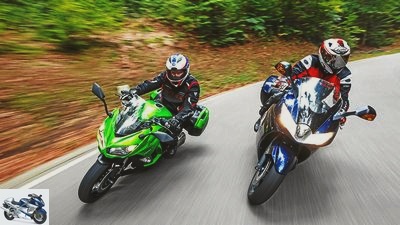
www.
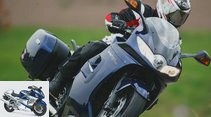
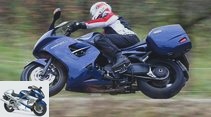
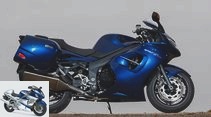
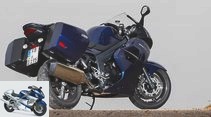
35 photos

www.
1/35
Sports tourers sit between all chairs, but the temptation lies in this niche: There are bikes with which you can do your sporty after-work round as well as the holiday trip.

www.
2/35
The Triumph Sprint GT pulls in wide curves as stable as a freight train on its way – at least on a level surface.

www.
3/35
The high weight and nine centimeters longer wheelbase dampen the handling, but have a calming effect in terms of stability and straight-line stability.
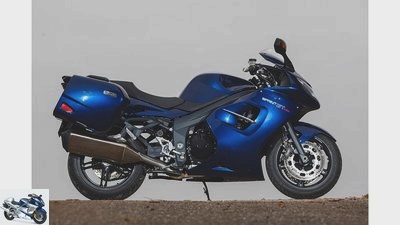
www.
4/35
In total, the Triumph Sprint GT weighs a whopping 270 kg.
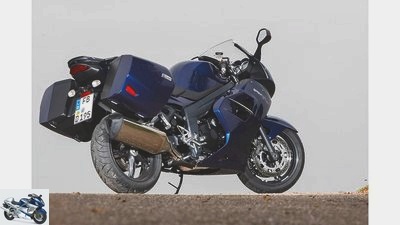
www.
5/35
The wide bench of the Triumph invites you to linger. A pillion passenger will also find a cozy place on the GT.
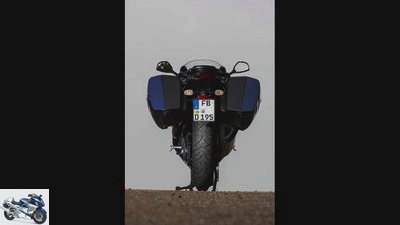
www.
6/35
Lots of storage space, great handling and at 100 cm not too wide: the luggage compartment of the Sprint GT.

www.
7/35
The Triumph Sprint GT is equipped with a three-cylinder four-stroke in-line engine.
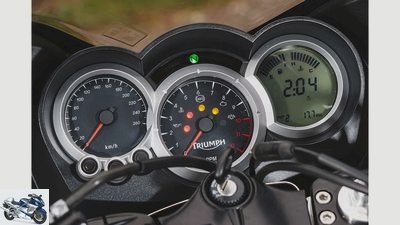
www.
8/35
Almost a little old-fashioned: the cockpit of the Triumph with a badly readable speedometer.
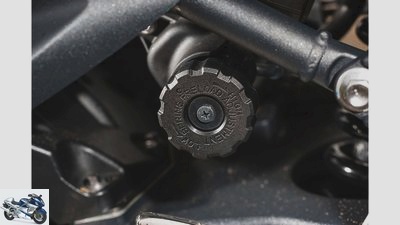
www.
9/35
Was on board from the start: handwheel on the shock absorber of the Triumph Sprint GT.
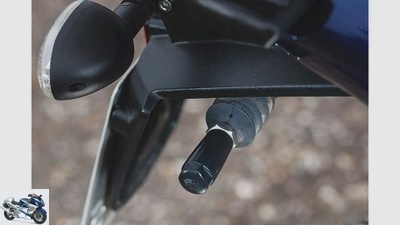
www.
10/35
The strut that both cases use to support each other is used for great high-speed stability.
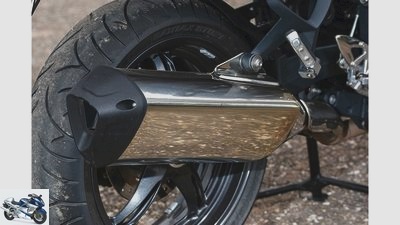
www.
11/35
The exhaust system of the Triumph Sprint GT.

www.
12/35
The Triumph case system.
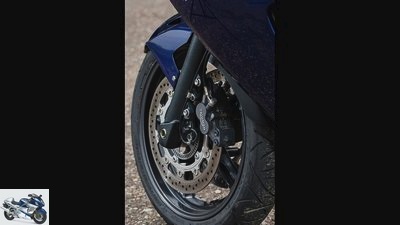
www.
13/35
The ABS-reinforced brakes grip properly the first time you put them on. But then you have to pull hard on the lever to slow down more.
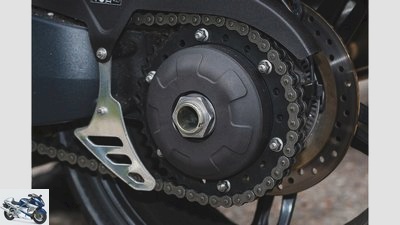
www.
14/35
Trademark of the large triples from Triumph: single-sided swing arm with eccentric.
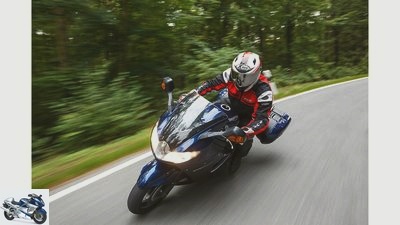
www.
15/35
The engine of the GT is also definitely available for dynamic locomotion: it hangs great on the gas, pulls as beefy as it is smooth and supple up to the limiter.
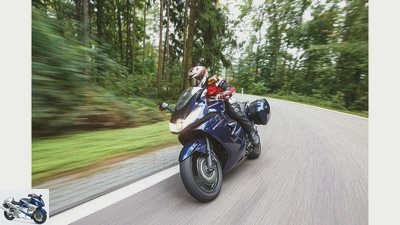
www.
16/35
The gearbox flawlessly lines up one gear into the next. This engine is still a piece of cake.
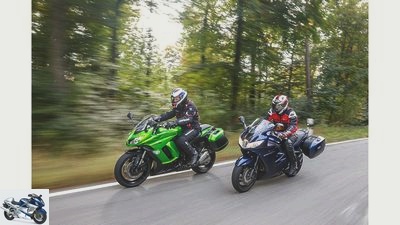
www.
17/35
At higher speeds, the Kawasaki steers more and more neutrally and is overall more agile than the Triumph.
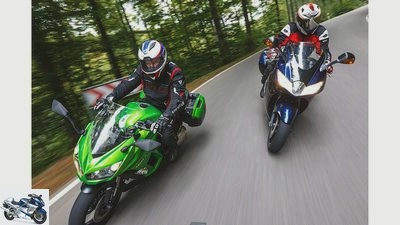
www.
18/35
The four-cylinder Kawasaki is more present than the Triumph three.
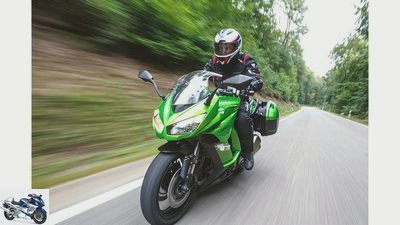
www.
19/35
It threads its way smoothly through the hustle and bustle of traffic and is easy to direct thanks to the relaxed seating position.
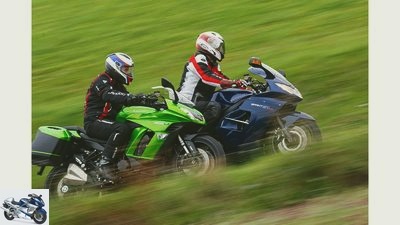
www.
20/35
In contrast to the radical looking Kawasaki, the Triumph dresses discreetly, avoiding flashy shapes and colors.
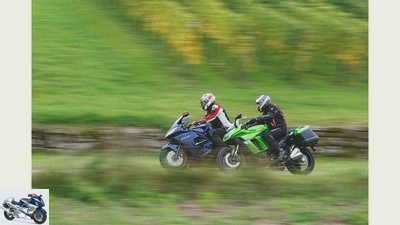
www.
21/35
The Kawasaki is clearly positioned in the sporty corner. The GT at the Triumph stands for Gran Turismo and signals that the Triumph is approaching from the quieter, touristy corner.
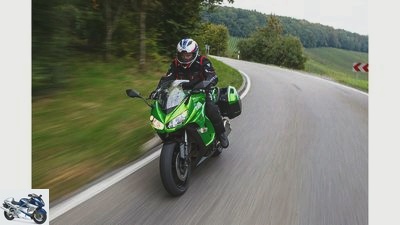
www.
22/35
The Kawasaki positions its rider more compactly, closer to the handlebars and more upright.
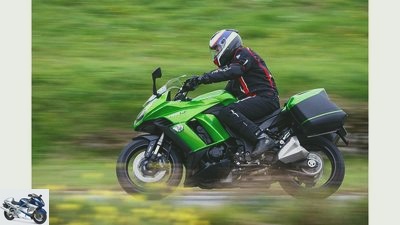
www.
23/35
The higher mounted pegs fold the legs a little more, although not uncomfortably.
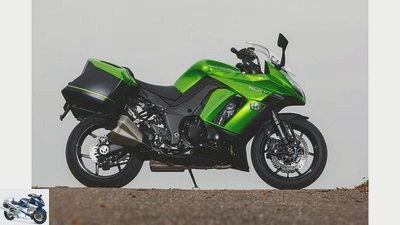
www.
24/35
The Kawasaki Z 100 SX Tourer has the radical shape familiar from the manufacturer.

www.
25/35
The wide, newly designed mirrors require a little attention.
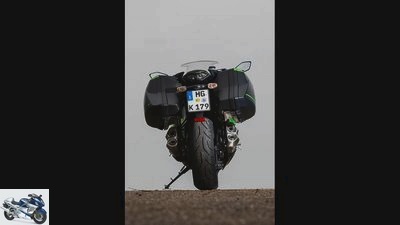
www.
26/35
Just 87 cm wide, the suitcases nestle against the rear of the Kawasaki.
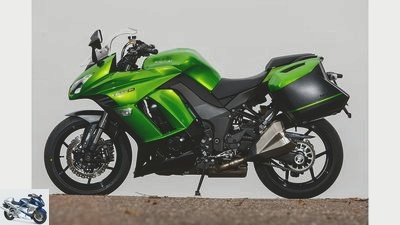
www.
27/35
The Kawasaki Z 1000 SX Tourer reaches a top speed of up to 244 km / h.
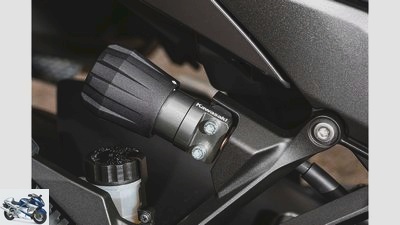
www.
28/35
The handwheel for adjusting the spring base is extremely useful, even if it is mounted a bit sloppy.
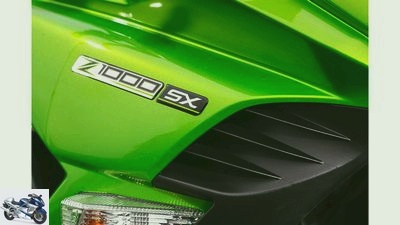
www.
29/35
The emblem of the Kawasaki Z 1000 SX Tourer.
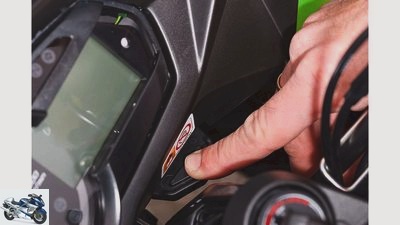
www.
30/35
Simple, but effective height adjustment of the windshield, unfortunately practically unusable while driving.
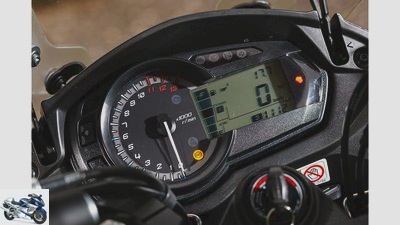
www.
31/35
The display is easy to read, can be operated from the handlebars, but only contains moderate information.
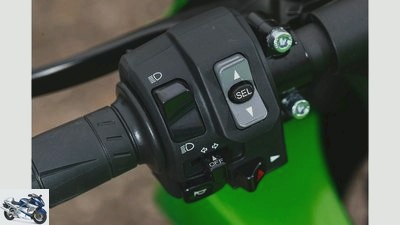
www.
32/35
The left handlebar grip with its amature.
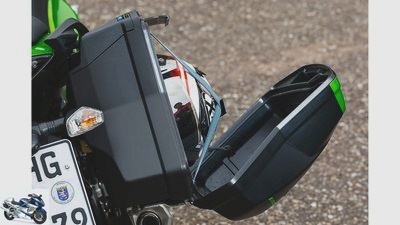
www.
33/35
The storage space is ideal for every trip.

www.
34/35
The Kawasaki four-cylinder gets down to business.
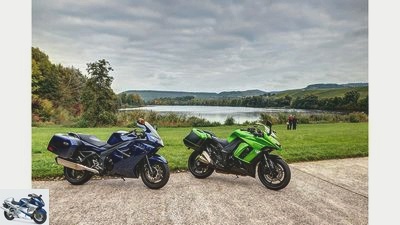
www.
35/35
The Triumph appears flat and elongated compared to the dynamic Kawa. For those who are more in the mood for enjoyable tours, the Triumph is ideal.
Kawasaki Z 1000 SX Tourer and Triumph Sprint GT in the test
Are sports tourers the golden mean?
Tourers are too big and sedate for you? Athlete too strenuous and nervous? Then the happy medium might be just right for you. We test the Triumph Sprint GT and the Kawasaki Z 1000 SX Tourer in comparison.
Somehow sports tourers are caught between all chairs. One thinks. But it is precisely in such gaps that successful and attractive little plants thrive. For example the Kawasaki Z 1000 SX. In terms of sales, it is practically on a par with the popular Z 1000. It’s also tempting: a bike with which you can do your sporty after-work tour as well as your holiday trip. To keep it that way, it received its first revision for 2014. In addition to standard suitcases, traction control and two engine mappings, it also brought monoblock brakes, a firmer chassis and more pulling power. In terms of performance, she is most likely to win the Triumph S.print GT hold a candle to it. Its bearish 1050 three-cylinder is a bench, the neat single-sided swing arm is pleasing to the eye.
Buy complete article
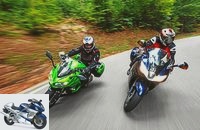
Kawasaki Z 1000 SX Tourer and Triumph Sprint GT in the test
Are sports tourers the golden mean?
Z 1000 SX with a name steeped in tradition and a self-confident appearance, clearly in the sportier corner.
Kawasaki Z 1000 SX is easier to direct
The seat rehearsal underlines the different approaches of the two. The driver sits on the Triumph Sprint GT, deeply integrated into the motorcycle, elongated and on softer upholstery. At the same time, with legs bent in a sporty way. The Kawasaki Z 1000 SX positions its rider more compactly, closer to the handlebar and more upright. The higher mounted pegs fold the legs a little more, although not uncomfortably.
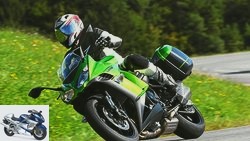
Tourer
Kawasaki Z 1000 SX (2014) in the driving report
Mild and wild combined even better?
read more
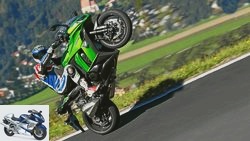
Tourer
Kawasaki Z 1000 SX in the PS driving report
More athletes than tourers?
read more
www.
At higher speeds, the Kawasaki steers more and more neutrally and is overall more agile than the Triumph.
Both of them do the start-up procedure without complaint. Only after cold, damp nights does the Kawasaki Z 1000 SX choke a little from the fuel it has been given for the first few meters before it willingly accepts gas. It threads its way more smoothly through the hustle and bustle of the city than the Triumph Sprint GT. And thanks to the more relaxed sitting position, it is easier to direct than the sprint, which, at a pounding 270 kilograms, not only carries 27 kilograms more with it, but also requires a more firm clutch hand. In addition, its turning circle of 7.3 meters is almost one and a half meters larger than that of the Kawa, which is annoying when maneuvering.
With the Kawasaki Z 1000 SX, on the other hand, only the wide, newly designed mirrors require a little attention, which compensate for this with good consideration. But we look ahead to the approaching exit and the waiting curves. There the triumph triple throws itself into the stuff. With this inimitable hiss, it pushes forward velvety, powerfully and with wonderful smoothness just above idle speed. He is not only acoustically flattering, but also moves on velvet paws through the speed range.
Lower load changes on the Triumph Sprint GT
The Kawasaki four-cylinder is no less powerful, but more robust. In addition to 3 HP more peak power, gentle engine modifications also brought a little more torque in the middle. This enabled the engineers to take sixth gear a little longer. The bottom line is that the draft values are unchanged. Whereby the four-cylinder is mechanically more present than the Triumph-Dreier. In addition, it reacts with the blink of an eye to the opening of the double throttle valves, especially at low speeds after rolling. Direct and easy to dose, with fewer load changes, on the other hand, the Triumph unit hangs on the gas. The streets are still narrow, the curves tight. The Triumph Sprint GT can be gently rocked from one side to the other in the rhythm of the curves, is not particularly handy, but its balance is right. She turns in well, lies stable, takes turns calmly. The Kawasaki Z 1000 SX, on the other hand, leans much more readily and easily, but tends to fold the front wheel inward in tight bends, which always requires some counter pressure on the handlebars and does not seem particularly neutral.

Tourer
Driving report: Triumph Sprint GT
Scotland test drive with Triumph’s new sports tourer
read more
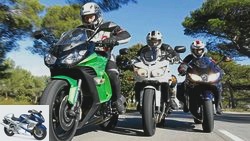
Tourer
Comparison test: sports tourer
Sports tourers from Kawasaki, Triumph and Yamaha in comparison
read more
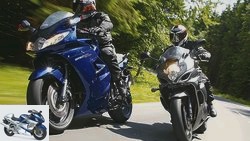
Tourer
Test: Triumph Sprint GT against Suzuki GSX 1250 FA
England versus Japan: sports tourers in the comparison test
read more
www.
In contrast to the radical looking Kawasaki, the Triumph dresses discreetly, avoiding flashy shapes and colors.
But the greater the speed and curve radii, the more the picture changes. At higher speeds, the Kawasaki Z 1000 SX steers more and more neutrally, is full and stable, even on pitted asphalt and on steep slopes. And it’s simply more agile overall. In wide curves, the Triumph Sprint GT pulls its way stably like a freight train – at least on a level surface. The high weight and nine centimeters longer wheelbase dampen the handling, but have a calming effect in terms of stability and straight-line stability. But if you take the “sprint” in its name too literally and give it the spurs, possibly even on an undulating surface, triumph gets moving. The softly cushioned spring elements respond cleanly to small bumps and ensure comfort. But not for rest on deck.
In addition, the sprint only provides average feedback, which dampens the physical activity, particularly with regard to the indifferent feeling for the front wheel. Whereby the engine is also definitely available for dynamic locomotion: it hangs great on the gas, pulls as beefy as it is smooth and smooth up to the limiter. And have we complained about bony Triumph transmissions in the past? This one perfectly lines up one aisle after the next. While downshifting is still a bit noisy, otherwise the gears slip perfectly. This engine is still a piece of cake.
The bottom line is that the Triumph Sprint GT is more of a comfortable travel companion than a sportsman, as the moderate pace is ultimately more suitable for it. Especially since the wide bench invites you to linger and a pillion passenger will find a more comfortable place here. The Triumph rests in itself and exudes serenity as you glide along the country roads. While the Kawasaki Z 1000 SX can hardly deny its sporty genes and blossoms with a brisk pace. The four-cylinder grumbles pithily, now hangs well on the gas at higher speeds. Turns up high, gives another power boost at 7000 rpm and only slacks off a little in the last 1000 revolutions.
The gears lock precisely and without great effort. Despite the slightly longer sixth gear, the four-cylinder engine derives its dynamism from an overall ratio that is still quite short. The Kawasaki Z 1000 SX runs into the limiter at top speed, and you always find yourself looking for a seventh gear. It should be translated even longer – not only from a tourist point of view. The chassis puts away sports insoles without complaint and provides better feedback – especially from the front wheel. The fully adjustable fork (Triumph: only preload) offers proper response and enough reserves for a brisk pace.
The Kawa can brake like the devil!
The spring strut, which is now equipped with a harder spring and, like the Sprint, can be adjusted in rebound and preload by handwheel, is not one of the most sensitive representatives of its kind, but it doesn’t get ugly hardness. The overall tight chassis setup does its part to ensure that the Kawasaki Z 1000 SX does not lose its footing in fast, undulating corners. The only thing to complain about is the noticeable righting moment when braking. But the Kawasaki can brake like the devil. A new radial brake pump and monoblock calipers ensure massive deceleration. The Z 1000 SX can be captured again with two fingers. And a finely regulated Bosch ABS ensures that nothing goes wrong in the heat of the moment. Only the lifting of the rear wheel cannot be completely prevented by the system. If the throttle grip is turned too vigorously, a three-stage traction control reliably monitors the rear wheel, which does not intervene too early and restrictively even at the most sensitive level.
The Triumph Sprint GT does not have that in its repertoire. Their brakes, which are also ABS-reinforced, look comparatively pale. Pack up properly when you first put on. But then you have to pull hard on the lever to slow down more. They do not achieve the bite or the controllability of the Kawa brake. If necessary, the ABS regulates reliably, but not as finely as that of the Kawasaki Z 1000 SX.
The Triumph scores elsewhere. The handling and locking of the large, but also heavy cases (6.9 kg each, Kawasaki: 4.0 each) is incredibly easy. Its vibration-decoupled suspension also ensures that the Sprint runs straight and bolt-stable even at high speeds. The main stand and single-sided swing arm facilitate chain maintenance and delight touring fans. The wind protection of the flat disc is average at best. The screen of the Kawasaki Z 1000 SX protects its pilot a little better, at least in the top tier. It is gratifying for both of them that they spare their drivers from annoying eddies and turbulence.
Triumph only swallows 5.1 liters
www.
The Triumph Sprint GT pulls in wide curves as stable as a freight train on its way – at least on a level surface.
At the gas pump, both of them make for happy faces. The Kawasaki Z 1000 SX, because with a consumption of 5.6 liters it is a few tenths more economical with fuel than its predecessor. The Triumph Sprint GT, because with a total of 5.1 liters it shows very moderate drinking habits. Which, in conjunction with the 20-liter tank (Kawasaki 19 liters), gives it a range of almost 400 kilometers.
A small compartment in the paneling holds at least a few utensils, the on-board socket and luggage rack facilitate the long tour, as does the generous 213 kilograms of payload. The range of accessories offers a top case with an integrated socket. But the cockpit of the Triumph, which can only be operated via fiddly buttons, does not have a gear and outside temperature display.
The cockpit of the Kawasaki Z 1000 SX, which can be operated from the handlebars, also suppresses this information. At 28 liters, your suitcases are also slightly smaller than those of the Triumph (31 liters), but still hold a full-face helmet. However, a load of 183 kilograms is not exactly large for the tour for two. But those who, like the Kawasaki, place more value on sporting attributes will be able to live with them. For those who are more in the mood for enjoyable tours, the Triumph is ideal.
Kawasaki Z 1000 SX Tourer
www.
The Kawasaki Z 100 SX Tourer has the radical shape familiar from the manufacturer.
engine
design type
In-line engine
Oil bath clutch
at 10,000 rpm
landing gear
| frame | Backbone frame aluminum |
| fork | Upside-down fork, Ø 41 mm |
| Brakes front / rear |
Ø 300 mm / Ø 250 mm |
| Assistance systems |
ABS, traction control |
| bikes |
3.50 x 17; 6.00 x 17 |
| tires |
120/70 ZR 17; 190/50 ZR 17 |
| Tires |
Bridgestone S 20 “N” |
mass and weight
| wheelbase | 1445 mm |
| Steering head angle | 65.5 degrees |
| trailing | 102 mm |
| Front / rear suspension travel | 120/138 mm |
| Seat height * | 820 mm |
| Weight with full tank ** | 243 kg |
| Payload * | 183 kg |
| Tank capacity / reserve | 19.0 liters |
| Service intervals | 6000 km |
| price | k. A.. |
| Price test motorcycle | k. A.. |
| Additional costs | 180 euros |
| * MOTORCYCLE measurements; ** MOTORCYCLE measurement including case weight (Kawasaki 2 x 4.0 kg; Triumph 2 x 6.9 kg |
|
MOTORCYCLE readings
| Top speed |
244 (249 *) km / h |
| acceleration 0-100 km / h 0-140 km / h 0-200 km / h |
3.3 sec 5.3 sec 9.8 sec |
| Draft 60-100 km / h 100-140 km / h 140-180 km / h |
3.4 sec 3.2 sec 3.6 sec |
| Consumption highway | 5.6 liters / super |
| Reach country road | 339 km |
| * Manufacturer information | |
Triumph Sprint GT
www.
In total, the Triumph Sprint GT weighs a whopping 270 kg.
engine
| design type | Three-cylinder four-stroke- In-line engine |
| injection |
Ø 46 mm |
| coupling | Multi-panes- Oil bath clutch |
| Bore x stroke |
79.0 x 71.4 mm |
| Displacement |
1050 cc |
| compression |
12.0: 1 |
| power | 96.0 kW (131 PS) at 9200 rpm |
| Torque |
108 Nm at 6300 rpm |
landing gear
| frame | Bridge frame aluminum |
| fork | Telescopic fork, Ø 43 mm |
| Brakes front / rear |
Ø 320 mm / Ø 255 mm |
| Assistance systems |
SECTION |
| bikes |
3.50 x 17; 5.50 x 17 |
| tires |
120/70 ZR 17; 180/55 ZR 17 |
| Tires |
Bridgestone BT 021 |
mass and weight
| wheelbase |
1537 mm |
| Steering head angle |
66.5 degrees |
| trailing |
84 mm |
| Front / rear suspension travel |
127/152 mm |
| Seat height * |
820 mm |
| Weight with full tank ** |
270 kg |
| Payload * |
213 kg |
| Tank capacity / reserve |
20.0 liters |
| Service intervals |
10000 km |
| price |
12,490 euros |
| Price test motorcycle |
12,490 euros |
| Additional costs |
450 euros |
| * MOTORCYCLE measurements; ** MOTORCYCLE measurement including case weight (Kawasaki 2 x 4.0 kg; Triumph 2 x 6.9 kg |
|
MOTORCYCLE readings
| Top speed | 237 (232 *) km / h |
| acceleration 0-100 km / h 0-140 km / h 0-200 km / h |
3.4 sec 5.7 sec 11.7 sec |
| Draft 60-100 km / h 100-140 km / h 140-180 km / h |
4.9 sec 5.2 sec 6.7 sec |
| Consumption highway |
5.1 liters / super |
| Reach country road |
392 km |
| * Manufacturer information | |
Scoring and conclusion
www.
The Triumph appears flat and elongated compared to the dynamic Kawa. For those who are more in the mood for enjoyable tours, the Triumph is ideal.
engine
| Maximum score |
Kawasaki Z 1000 SX Tourer |
triumph Sprint GT |
|
| Draft | 40 | 36 | 28 |
| acceleration | 40 | 32 | 30th |
| Top speed | 30th | 21st | 20th |
| Engine characteristics | 30th | 26th | 24 |
| Responsiveness | 20th | 14th | 15th |
| Load change | 20th | 14th | 14th |
| Smoothness | 20th | 11 | 13 |
| coupling | 10 | 9 | 7th |
| circuit | 20th | 15th | 14th |
| Gear ratio | 10 | 8th | 8th |
| Start | 10 | 8th | 8th |
| total | 250 | 194 | 181 |
The three-cylinder of the Triumph runs noticeably quieter and has the smoother response. But the Kawasaki four-wheeler impresses – not least thanks to its short overall gear ratio – with excellent acceleration and, above all, torque. The Triumph clutch also requires more manual effort.
Winner engine: Kawasaki Z 1000 SX
landing gear
| Maximum score |
Kawasaki Z 1000 SX Tourer |
triumph Sprint GT |
|
| Handiness | 40 | 27 | 23 |
| Stability in turns | 40 | 29 | 26th |
| Steering behavior | 40 | 28 | 27 |
| feedback | 10 | 8th | 6th |
| Inclined position | 20th | 16 | 16 |
| Straight-line stability | 20th | 15th | 18th |
| Suspension tuning in front | 20th | 14th | 12th |
| Chassis set-up at the rear | 20th | 14th | 13 |
| Adjustment options undercarriage | 10 | 7th | 4th |
| Suspension comfort | 10 | 6th | 7th |
| Driving behavior with a passenger | 20th | 14th | 14th |
| total | 250 | 178 | 166 |
This chapter goes to the Kawasaki. The Triumph scores at least with an imperturbably stable straight line and comfortable chassis. The Kawa is not so precise with neutrality, especially at low speeds, but is much more manageable and, thanks to the tighter set-up, is noticeably more stable when sharpening corners quickly.
Chassis winner: Kawasaki Z 1000 SX
everyday life
| Maximum score |
Kawasaki Z 1000 SX Tourer |
triumph Sprint GT |
|
| Ergonomics driver | 40 | 29 | 28 |
| Ergonomics pillion | 20th | 9 | 12th |
| Windbreak | 20th | 14th | 13 |
| view | 20th | 12th | 12th |
| light | 20th | 13 | 16 |
| Furnishing | 30th | 20th | 13 |
| Handling / maintenance | 30th | 16 | 13 |
| Luggage storage | 10 | 6th | 9 |
| Payload | 10 | 4th | 9 |
| Range | 30th | 20th | 25th |
| processing | 20th | 14th | 15th |
| total | 250 | 157 | 165 |
Even if the Triumph clinches a partial victory here, the Kawasaki offers the more upright, more relaxed seating position. And also the more extensive equipment. Tour fans are better served with the Triumph thanks to the luggage rack, storage compartment and socket, as well as range and payload. The information content of the displays could be improved in both cases.
Winner everyday life: Triumph Sprint GT
security
| Maximum score |
Kawasaki Z 1000 SX Tourer |
triumph Sprint GT |
|
| Braking effect | 40 | 32 | 27 |
| Brake metering | 30th | 27 | 22nd |
| Braking with a passenger / fading | 20th | 15th | 14th |
| Righting moment when braking | 10 | 6th | 7th |
| ABS function | 20th | 15th | 11 |
| Handlebar slapping | 20th | 13 | 17th |
| Ground clearance | 10 | 7th | 8th |
| total | 150 | 115 | 106 |
The Kawasaki lands a direct hit with its new brakes. Spontaneous and bulky to grab, and easy to dose. The new Bosch ABS also pleases with its short control intervals.
Safety winner: Kawasaki Z 1000 SX
costs
| Maximum score |
Kawasaki Z 1000 SX Tourer |
triumph Sprint GT |
|
| guarantee | 30th | 15th | 18th |
| Consumption (country road) | 30th | 16 | 19th |
| Inspection costs | 20th | 10 | 16 |
| Maintenance costs | 20th | 7th | 8th |
| total | 100 | 48 | 61 |
Longer inspection intervals and warranty, plus lower fuel consumption: a clear case for the Sprint GT.
Winner costs: Triumph Sprint GT
Performance measurement
BILLION
The performance measurement of the Kawasaki Z 1000 SX Tourer and Triumph Sprint GT.
If you look at the power and especially the torque curves in connection with the pulling power, you rub your eyes in amazement. But the Kawasaki Z 1000 SX benefits enormously from its significantly lower weight and the overall shorter overall gear ratio, so that the Triumph loses out in the pull-through test.
Easy to see: the power curve that flattens out from 9000 rpm. The Triumph Sprint GT has around 95 Nm of torque just above idle speed, and from 3500 rpm it is permanently over 100 Nm. What gives the three-cylinder its rustic character and sovereign appearance and makes it a pleasant companion in everyday life.
Test result
| Maximum score |
Kawasaki Z 1000 SX Tourer |
triumph Sprint GT |
|
| Overall rating | 1000 | 692 | 679 |
| placement | 1. | 2. | |
| Price-performance rating | 1.0 | – | 1.9 |
Winner price-performance:
The Triumph Sprint GT deserves a good grade, Kawasaki could not name a price at the time of the test.
1st place: Kawasaki Z 1000 SX Tourer
Clear thing for the revised Greens. It is more handy, brakes better, meets sporting expectations more without being uncomfortable. In terms of neutrality and equipment suitable for touring, however, it can also improve.
2nd place: Triumph Sprint GT
The elongated seating position is not typical for tourers, but the chassis is comfortable and stable. The GT is economical and can haul properly. But handling and braking are just average. Equipment and wind protection as well.
Related articles
-
Ducati Multistrada 1200, Kawasaki Versys 1000 and Triumph Tiger 1050 in the test
Gargolov Funbikes in comparison test Ducati Multistrada 1200, Kawasaki Versys 1000 and Triumph Tiger 1050 With bags and bags on a big tour or just an…
-
factstudio.de 29 photos fact 1/29 One against all. Ducati SuperSport S in comparison test with Suzuki GSX-S 1000 F, Kawasaki Z 1000 SX, Honda VFR 800 F…
-
Comparison test: Honda CB 1000 R, Yamaha FZ1, Triumph Speed Triple, Kawasaki Z 1000
Comparison test: Honda CB 1000 R, Yamaha FZ1, Triumph Speed Triple, Kawasaki Z 1000 Large naked bikes in comparison Content of At its…
-
Comparison test Aprilia, Ducati, Kawasaki, KTM and Triumph
Artist Comparison test Aprilia, Ducati, Kawasaki, KTM and Triumph Cool naked bikes Minimalistic, aggressive, greedy and cool ?? Naked bikes focus the…
-
BMW, Kawasaki, Triumph and Yamaha Tourer in comparison test
Gargolov 31 photos Gargolov 1/31 Tourer comparison test: Triumph Trophy SE, BMW R 1200 RT, BMW K 1600 GT, Yamaha FJR 1300 and Kawasaki 1400 GT. Gargolov…
-
Aprilia Tuono V4 1100 RR, Kawasaki Ninja H2 and BMW S 1000 XR in the comparison test
Arturo Rivas Gonzalez 31 photos Arturo Rivas Gonzalez 1/31 Aprilia Tuono V4 1100 RR, Kawasaki Ninja H2 and BMW S 1000 XR. Arturo Rivas Gonzalez 2/31 And…
-
Comparison test BMW S 1000 RR, Kawasaki ZX-10R and Yamaha YZF-R1M
22nd photos 1/22 BMW S 1000 RR, Kawasaki Ninja ZX-10R and Yamaha YZF-R1M. 2/22 Yamaha YZF-R1M. 3/22…
-
35 photos 1/35 BMW S 1000 R, Ducati Monster 1200 S, KTM 1290 Super Duke R and Triumph Speed Triple R in comparison test….
-
Comparison test of the 1000 super sports car
Jaime de Diego 38 photos fact 1/38 Yamaha charges 14,895 euros for their completely new R1 super sports bike. fact 2/38 Even without ABS, the Fireblade…
-
Kawasaki Versys 1000, Triumph Tiger 1050 Sport, Honda Crossrunner in comparison test
28 photos 1/28 After the romping comes the touring: gasoline talks at the former coal port in Karlsruhe….